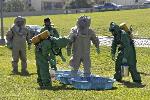Training and Exercises

Abundant resource of training opportunities.
|

Creating a better prepared America.
|
FEMA provides a variety of training and exercise resources applicable to emergency managers; Federal, state, and local governmental representatives; non governmental organizations; and the private sector. FEMA training and exercise programs help ensure a better prepared nation by training students about prevention, protection, response, and recovery capabilities required for all hazards, natural or manmade.
Exercises validate training and determine strengths, areas for improvement, and identify corrective actions and lessons learned to drive subsequent planning, training, and exercise activities.
The information below provides overviews of various FEMA training and exercise programs and links to web-based resources; and enables stakeholders to sort and view specific course details by audience or topic.
Training Overview
FEMA provides tailored training to enhance the capacity of the Federal Government; state and local jurisdictions; non-governmental organizations; and the private sector to prevent, protect, respond to, and recover from all hazards, natural or manmade. Specifically, FEMA training is designed to meet the diverse needs of its various audiences. This is accomplished by reaching multiple disciplines through training at the awareness, performance and planning/management levels, and employing the most appropriate mediums and vehicles for the particular audience.
FEMA designs, develops, conducts, and evaluates hundreds of training courses. The courses are managed and maintained by several FEMA training entities. Entities may focus on delivering training related to one or several disciplines, while coordinated with their FEMA counterparts to avoid any duplicative efforts.
FEMA training comports with nationally recognized standards, adheres to the precepts of Instructional System Design (ISD), and utilizes adult learning principles, including problem-based learning. In addition, FEMA training endures a rigorous validation process before delivery, and continuous assessment once training deliveries are initiated.
Search for Training Information
By Audience
- Individuals (Citizen’s, homeowner’s, pet owners)
- Emergency Managers (Emergency Personnel, Government Personnel)
- Businesses and Farmers
- Teachers
- Tribal Representatives
- Volunteer Agencies
By Topic
- Continuity of Operation (COOP)
- Cooperating Technical Partners (CTP)
- Emergency Management
- Environment and Historic Preservation (EHP)
- Exercises
- Flood Hazard Mapping (FHM)
- Floodplain Management
- HAZUS
- National Dam Safety Program (NDSP)
- National Earthquake Hazards Reduction Program (NEHRP)
- National Flood Insurance Program (NFIP)
- National Incident Management System (NIMS)
- Natural Hazards Mitigation Planning
- Tribal
Exercise Overview
Exercises provide first responders and emergency management officials with an opportunity to assess their ability to prevent, protect against, respond to, or recover from a disaster. If they are conducted effectively, exercises help identify strengths and areas for improvement in plans, procedures, and capabilities for response before a disaster or act of terrorism occurs.
National Exercise Program
The National Exercise Program (NEP) meets Homeland Security Presidential Directive (HSPD) 8 and Homeland Security Act of 2002 requirements to establish a national, interagency-wide program to coordinate homeland security preparedness-related exercise activities. The NEP provides an organized approach to set priorities for exercises, reflect those priorities in a multi-year schedule of exercises that serves the strategic and policy goals of the U.S. Government, and address findings from those exercises through a disciplined interagency process. The NEP establishes the Homeland Security Exercise and Evaluation Program as the exercise methodology and tools to support the NEP. More information on the National Exercise Program can be found here.
Homeland Security Exercise and Evaluation Program
The Homeland Security Exercise and Evaluation Program (HSEEP) is a capabilities and performance-based exercise program that provides a standardized policy, methodology, and language for designing, developing, conducting, and evaluating all exercises. Find out more information on HSEEP resources on the HSEEP page.
Radiological Emergency Preparedness (REP) Program On December 7, 1979, following the Three Mile Island nuclear power plant accident in Pennsylvania, President Carter transferred the Federal lead role in offsite radiological emergency planning and preparedness activities from the U.S. Nuclear Regulatory Commission (NRC) to the Federal Emergency Management Agency (FEMA). FEMA established the Radiological Emergency Preparedness (REP) Program to (1) ensure the health and safety of citizens living around commercial nuclear power plants would be adequately protected in the event of a nuclear power plant accident; and (2) inform and educate the public about radiological emergency preparedness. REP Program responsibilities encompass only “offsite” activities, that is, State, tribal and local government emergency planning and preparedness activities that take place beyond the nuclear power plant boundaries.
Chemical Stockpile Emergency Preparedness Program (CSEPP)
Currently, the US stockpile of chemical agents is safely stored at seven sites across the country. These sites are located in Alabama, Arkansas, Colorado, Indiana/Illinois, Kentucky, Oregon/Washington, and Utah.
Since 1988, FEMA and the U.S. Army have assisted communities surrounding the seven chemical stockpile sites to enhance their abilities to respond to the unlikely event of a chemical agent emergency. This success of CSEPP initiatives depends on the productive working partnerships enjoyed by federal, state, and local jurisdictions involved in the program.
Additional Resources
References
- Training and Exercise Integration (TEI) Course Catalog (PDF 1MB, TXT 355KB)
- National Preparedness Guidelines (PDF 560KB, TXT 117KB)
- Target Capabilities List (PDF 4.2MB, TXT 117KB)
- National Response Framework
Online Tools
- Lessons Learned Information Sharing (LLIS)
- First Responder Training Portal
- HSEEP Toolkit
- Preparedness Portal
- Responder Knowledge Base
Training Websites
- U.S. Fire Administration (USFA)
- Center for Domestic Preparedness (CDP)/Noble Training Center
- Emergency Management Institute (EMI)
Exercise Websites
- Homeland Security Exercise and Evaluation Program
- Radiological Emergency Preparedness Program
- Chemical Stockpile Emergency Preparedness Program
Download Plug-in
Some of the links on this page require a plug-in to view them. Links to the plug-ins are available below.
Last Modified: Friday, 05-Dec-2008 12:01:12 EST
References
- Training and Exercise Integration (TEI) Course Catalog [.PDF]
- National Preparedness Guidelines [.PDF]
- Additional References
Online Tools
Training
- U.S. Fire Administration (USFA)
- Center for Domestic Preparedness
- Emergency Management Institute (EMI)
Related Topics
- Other Training Partners
- Competitive Training Grants Program (CTGP)
- The National Domestic Preparedness Consortium (NDPC)
